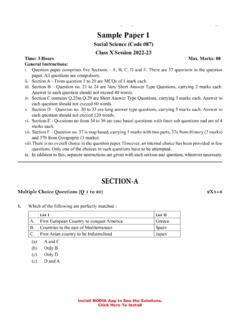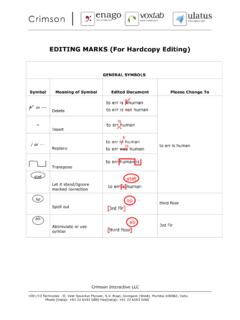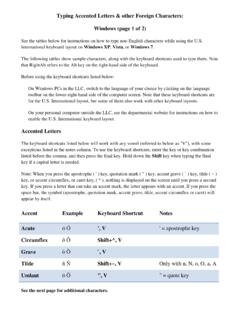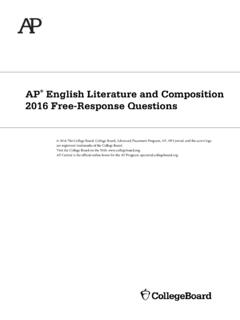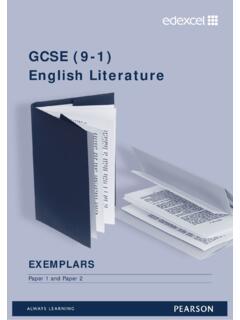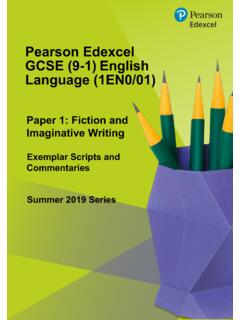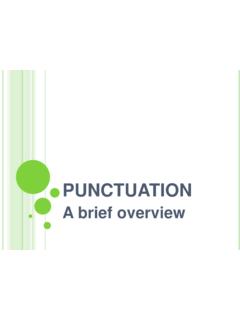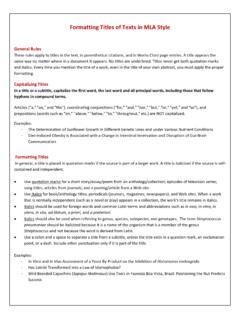Transcription of SECTION A- READING (10 marks)
1 To get 30 Sample Papers with full solution whatsapp at 89056 29969. Page 58 Sample Paper 7 CBSE English Class 10. Sample Paper 7. Class X Exam 2021-22 (TERM II). English - Language and Literature (184). Time Allowed: 2 Hrs. Maximum marks : 40. General Instructions: 1. The question Paper contains THREE sections- READING , WRITING & GRAMMAR and LITERATURE. 2. Attempt questions based on specific instructions for each part. SECTION A- READING (10 marks ). 1. Read the passage given below. 1*5. 1. The Hangul deer or the Kashmiri stag is a species of red deer. The Hangul is one of the most famous animals of Jammu and Kashmir. It inhabits the dense forests of the state. Striking in appearance, the Hangul derives its name from han' which is the local name for the horse chestnut tree, the fruit of which the deer feed on.
2 2. Scientifically known as Cervuselaphus hanglu, Hangul is the only surviving race of the red deer family of Europe in the sub continent. The Hangul deer's coat is brown with slight speckles and each of its antlers consists of five points. 3. Much at home in the forest, the deer can be seen in the lower valleys of Dachigam National Park on the foothills of the Zabarwan range on the outskirts of Srinagar for most parts of the year, though a greater number of their species can be seen from October to March. Normally found in small groups of two to eighteen, Hanguls use the forests of the Dachigam Valley as an important feeding ground and move to the higher slopes to graze. Individual stags are more likely to be seen feeding on the hill slopes. They move about quite a lot from one area to another in their search for good forage.
3 Hanguls eat various plants such as Fraximushockeri, Jasminum humile, Hemerocallisfulva and perennial herbs, depending on the season. 4. In March and April, the stags shed their antlers and begin moving up the mountains to the alpine meadows and pine forests of Upper Dachigam between 2500 to 3500 metres. They return to the lower valley in September, by when a new set of antlers begin to grow. The natural predators that attack Hanguls are leopards and Himalayan black bears. 5. In the past, Jammu and Kashmir had a large and vibrant population of Hangul deer. However, hunting and loss of habitat from deforestation and the building of dams has significantly curbed the wild population of Hangul deer. During the 1940s, their number was believed to be around 3,000 5,000. As per the latest census in 2008, only 160 are left.
4 A captive breeding center is planned to be commissioned at Shikargah, Tral in south Kashmir, for the captive breeding of Hangul, which will be eventually released in the wild. 6. In the last few years, the government has spent crores of rupees on different projects related to the conservation of Hangul in Jammu and Kashmir. A Habitat Research Study has been initiated in Kashmir in which satellite collaring of Hangul will be used in order to understand their movement patterns and habitat, both in and outside the Dachigam National Park. In addition, a massive improvement in conducting the census programme of Hangul has been undertaken whereby satellite telemetry and field cameras of high definition are being placed in the Park. Besides, an important research programme has been launched to study the relic population of Hangul outside Dachigam National Park in collaboration with the Wildlife Trust of India.
5 7. The strict enforcement of wildlife acts and the setting up of new initiatives are anticipated to replenish this highly endangered species. Based on your understanding of the passage, answer ANY FIVE questions from the six given below. i. What is the other name for the Hangul deer? ii. What makes the Hangul deer stand out from others of its species? iii. Why is the deer named so? CLICK HERE or whatsapp at 89056 29969 to Purchase Hard Books of CBSE Online Sample Papers. 21 Sample Paper in Each Subject and Rs 499/- For 4 Subjects To get 30 Sample Papers with full solution whatsapp at 89056 29969. CBSE English Class 10 Sample Paper 7 Page 59. iv. How is the deer's habitat conducive to its existence? v. What are the factors which prevent the population of this species from growing? vi. Rewrite the following sentence by replacing the underlined phrase with a word that means the same from para 6.
6 It took an international act of working together between Martienssen's group at Cold Spring Harbor Lab and their colleagues at the Malaysian Palm Oil Board nearly 20 years to unravel the mystery of the mantled fruit. 2. Read the case based factual passage given below. 1*5. 1. India is home to million stunted children, a third of world's total as per Global Nutrition Report 2018. Nearly half of all under-5 child mortality in India is attributable to undernutrition. Any country cannot aim to attain economic and social development goals without addressing the issue of malnutrition. Poor nutrition in the first 1000. days of a child's life can also lead to stunted growth, which is associated with impaired cognitive ability and reduced school and work performance. Malnutrition in children occurs as a complex interplay among various factors like poverty, maternal health illiteracy, diseases like diarrhoea, home environment, dietary practices, hand washing and other hygiene practices, etc.
7 Low birth weight, episode of diarrhoea within the last 6 months and the presence of developmental delay are often associated with malnutrition in most developing nations including India. 2. In present era malnutrition is reflected as double burden, one aspect is undernutrition and other being overnutrition. But, in India and other low and middle-income countries (LMICs), basically malnutrition is synonymous with protein energy malnutrition or undernutrition, which signifies an imbalance between the supply of protein and energy and the body's demand for them to ensure optimal growth and function. 3. Globally, approximately 149 million children under-5 suffer from stunting. In 2018, over 49 million children under-5. were wasted and nearly 17 million were severely wasted. There are now over 40 million overweight children globally, an increase of 10 million since 2000.
8 It is estimated that by 2050, 25 million more children than today will be malnourished . 4. India is one among the many countries where child undernutrition is severe and also undernutrition is a major underlying cause of child mortality in India. In a recently released Global Nutrition Report 2018, revealed the prevalence of stunting, wasting and overweight at national level as , and respectively. 5. In India as per National Family Health Survey IV (2014-2015, recent in the series) , 21 and of children below 5 years suffer from stunting, wasting and underweight respectively (corresponding figure for NFHS III, 2005- 2006 were , and respectively). Prevalence of severe acute malnutrition (SAM) in India is CLICK HERE or whatsapp at 89056 29969 to Purchase Hard Books of CBSE Online Sample Papers. 21 Sample Paper in Each Subject and Rs 499/- For 4 Subjects To get 30 Sample Papers with full solution whatsapp at 89056 29969.
9 Page 60 Sample Paper 7 CBSE English Class 10. 6. In the 2018 Global Hunger Index, India ranks 103rd out of 119 qualifying countries. With a score of , India suffers from a level of hunger that is serious. Figure given depicts dimensions and indicators of Hunger index and its relationship with child malnutrition. On the basis of your understanding of the Passage, answer ANY FIVE questions from the six given below. i. What is a major underlying cause of child mortality in India. ii. By what year is it estimated that globally 25 million more children will be malnourished? iii. What is an indicator of inadequate food supply? iv. What does Undernutrition signify? v. What did the Global Nutrition Report, 2018 reveal? vi. What does the author mean by underlying cause' ? SECTION B- WRITING & GRAMMAR (10 marks ).
10 3. Attempt ANY ONE from i and ii. 5. i. The pie chart shows the proportion of people from different households living in poverty in the UK in 2002. Write an analytical paragraph to describe the information in not more than 120 words. ii. You are Sohan/Shilpa Proprietor of M/s Agarwal Surgicals, Naraina, New Delhi. Place an order for surgical instruments that you wish to purchase for your firm. Write a letter to the Manager, M/s ABC Surgicals & CO., Asaf Ali Road to send items with discounts. 4. The following paragraph has not been edited. There is one error in each line. Identify the error and write its correction against the correct blank number. Remember to underline the correction. The first one has been done for you. 1*3. Error Correction Neil Armstrong were the commander of Apollo 11. were was He was the first to walked on (a).





